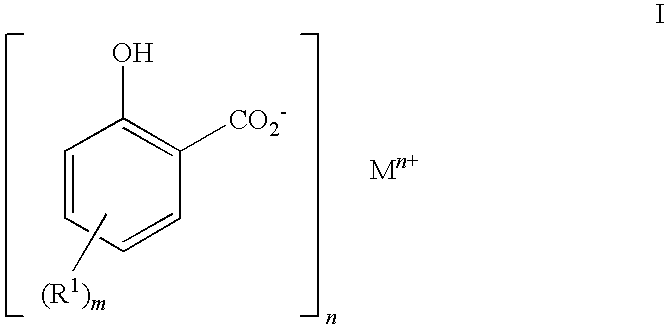Method of Reducing Asphaltene Precipitation in an Engine
a technology of asphaltene and precipitation, which is applied in the direction of fuel additives, liquid carbonaceous fuels, base materials, etc., can solve the problems of crankcase explosion and crack formation, and achieve the effect of improving asphaltene dispersion performance and asphaltene dispersion performan
- Summary
- Abstract
- Description
- Claims
- Application Information
AI Technical Summary
Benefits of technology
Problems solved by technology
Method used
Image
Examples
example 1
Preparation of C22 Ortho-Alkyl Phenol
[0122]Fe(acac)3 (iron acetylacetonate complex, 0.228 g) was weighed into a 100 mL 3-neck flask to which was added 1-bromododocosane (5.0 g), N-methyl pyrrolidinone (5.26 ml) and then THF (6 ml). The resulting solution was cooled to 0° C. and then a solution of the Grignard reagent (2-methoxyphenyl magnesium bromide (18.64 ml of a 1M solution in THF)) was added dropwise over two hours using a syringe pump. The reaction was allowed to stir overnight in an ice bath and then gradually warmed to room temperature. The contents of the reaction flask were then mixed with toluene and poured into a separating funnel. HCl solution (10% (v / v)) was then added to acidify the toluene. The upper toluene layer was then washed with water, the toluene filtered into a round-bottomed flask and the solvent stripped using a rotary evaporator.
[0123]HBr (0.82 mol, 54 mL) was added to a 1 litre 3-neck flask containing the anisole made in the previous step (30 g) and tribu...
example 2
Preparation of C22 Ortho-Alkyl Salicylic Acid
2.1 Phenation Step
[0124]The C22 ortho-alkylphenol of Example 1 (33.78 g) was weighed into a 3 litre 3-necked boiling flask and xylene (1000 ml) added using a measuring funnel. The flask was set up for distillation and nitrogen was blanketed over the mixture at 400 ml.min−1. Stirring was then started at approx. 300 rpm and the mixture heated with an oil bath set to 100° C. An aqueous sodium hydroxide solution (50%, 7.4 ml) was charged to a small pressure equalised addition funnel and a vacuum applied and increased until the xylene just started to distil over. The sodium hydroxide was then added dropwise to the xylene / alkylphenol mixture. Approx. 250 ml of the xylene / water mixture was distilled off under vacuum to ensure that all the water had been removed. After distillation the flask was allowed to cool to approx. 80° C.
2.2 Carboxylation Step
[0125]After cooling, the contents of the flask from step 2.1 above were transferred to a 2 litre a...
example 3
Preparation of Low Base Calcium C22 Ortho-Alkyl Salicylate
[0130]The C22 ortho-alkyl salicylic acid of Example 2 was mixed with a commercial lower alkyl (i.e. less than C20) salicylic acid (Infineum M7103, obtainable from Infineum UK Limited) on a 80:20 mol:mol basis (Example 2: commercial salicylic acid). The salicylic acid mixture (10.4 g) and xylene (76.3 g) were mixed together at room temperature. Calcium hydroxide (2.87 g) and further xylene (100 g) were added, nitrogen passed through the mixture (60 ml.min−1) and the resulting mixture heated in an oil bath. When the mixture reached a temperature of 42.3° C., a promoter (methanol:water (97%:3%), 20.46 ml) was added and the resulting mixture stirred at 40.6° C. for 1 hour.
[0131]The mixture was then transferred to a centrifuge and spun at 1500 rpm for 1 hour. The supernatant liquid was transferred to a 3-necked flask and nitrogen passed through the mixture at 60 ml min−1 with stirring at 400 rpm and heating to 54.3° C. Carbon diox...
PUM
| Property | Measurement | Unit |
|---|---|---|
| mass % | aaaaa | aaaaa |
| viscosity index | aaaaa | aaaaa |
| viscosity index | aaaaa | aaaaa |
Abstract
Description
Claims
Application Information
 Login to View More
Login to View More - R&D
- Intellectual Property
- Life Sciences
- Materials
- Tech Scout
- Unparalleled Data Quality
- Higher Quality Content
- 60% Fewer Hallucinations
Browse by: Latest US Patents, China's latest patents, Technical Efficacy Thesaurus, Application Domain, Technology Topic, Popular Technical Reports.
© 2025 PatSnap. All rights reserved.Legal|Privacy policy|Modern Slavery Act Transparency Statement|Sitemap|About US| Contact US: help@patsnap.com

